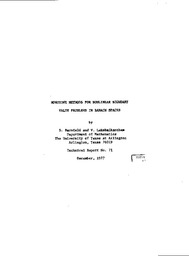
ATTENTION: The works hosted here are being migrated to a new repository that will consolidate resources, improve discoverability, and better show UTA's research impact on the global community. We will update authors as the migration progresses. Please see MavMatrix for more information.
Show simple item record
| dc.contributor.author | Bernfeld, Stephen R. | en |
| dc.contributor.author | Lakshmikantham, V. | en |
| dc.date.accessioned | 2010-06-03T14:55:38Z | en |
| dc.date.available | 2010-06-03T14:55:38Z | en |
| dc.date.issued | 1977-12 | en |
| dc.identifier.uri | http://hdl.handle.net/10106/2286 | en |
| dc.description.abstract | **Please note that the full text is embargoed** ABSTRACT: Monotone methods have been used to generate multiple solutions of nonlinear boundary value problems for both ordinary and partial differential equations. Keller [10] and Sattinger [13], extending the chord method, considered nonlinear partial differential equations containing no gradient term. The inclusion of the gradient term was first introduced by Chandra and Davis [6] who considered the ordinary boundary value problem
(1.1) [see pdf for notation]
(1.2) [see pdf for notation]
Here [see pdf for notation]. They assumed that f depends linearly on [see pdf for notation]; and this restriction on [see pdf for notation]' was eliminated by Bernfeld and Chandra [3] and by Amann and Crandall [1] in the case of elliptic differential equations. The extension of these
results to [see pdf for notation] was accomplished by Chandra, Lakshmikantham, and Leela [8]. This extension is important, for parabolic equations of the form
[see pdf for notation]
can be approximated, using the method of lines, by n-dimensional and infinite dimensional systems of type (1.1) (See Liskovets [11] and Thompson [15]). This leads to important numerical considerations for the solution of initial-boundary value problems for nonlinear parabolic partial differential equations.
The approach used in the above mentioned papers is to ascertain the existence of a lower solution [see pdf for notation] and upper solution [see pdf for notation] of (1.1), (1.2) such that [see pdf for notation]. By assuming a Nagumo condition on [see pdf for notation] one is able to obtain the existence of a solution [see pdf for notation] such that [see pdf for notation]. In order to obtain the monotone iterations one considers
(1.3) [see pdf for notation]
where [see pdf for notation] where [see pdf for notation]
and [see pdf for notation] and [see pdf for notation], where N is a prescribed constant arising from the Nagumo condition. The existence of solution of (1.3), (1.2) follows as in (1.1), (1.2). Moreover by using the classical maximum principle (in RI) or a more generalized comparison result in [see pdf for notation] [8] one obtains for each [see pdf for notation] such that [see pdf for notation] a unique solution [see pdf for notation] of (1.3), (1.2) such
that [see pdf for notation]. Letting A be the mapping defined by
[see pdf for notation], one shows (using the maximum principle or generalized comparison result) that [see pdf for notation] and A is monotone, that is
[see pdf for notation] implies [see pdf for notation]. Finally by defining the sequences
[see pdf for notation] one obtains that [see pdf for notation] converge monotonically to the minimal and maximal solutions of (1.1), (1.2) of.
lying in the segment [see pdf for notation]. If (1.1), (1.2) has only one solution in [see pdf for notation] then [see pdf for notation] and [see pdf for notation] both converge to this solution.
In this paper we study the boundary value problem (1.1), (1.2) in an arbitrary Banach Space E. The extension of (1.1), (1.2) from [see pdf for notation] [8] to E requires some significant changes. For example, we talk
about orderings induced by cones that are generated by linear functionals. We do not require the cones to have interior as is the case in [see pdf for notation] [8] and as is sometimes assumed in [17]. Moreover we develop a comparison principle that leads to the monotonicity of A which reduces to
the case in [8] when [see pdf for notation] and the cone is generated by the positive functionals. In addition we give conditions when the lower solution [see pdf for notation] (upper solution) by using ideas from the maximum principle combined with a result of Schroder's [14] concerning inverse monotone mappings. In many of the above papers it is assumed that [see pdf for notation]. Using an idea of Amann and Crandall [1] and a technique in [2], we
weaken the growth condition in [3], [8] of [see pdf for notation] on [see pdf for notation], essentially assuming quadratic growth. Finally, we weaken the assumption of
4
complete continuity on f by imposing conditions on f in terms of the measure of noncompactness. (See [9]).
We conclude the paper with an indication of the application of our method to systems of partial differential equations, a problem of great importance, for example, in applications. An expository version of this paper was presented at a recent U. S. Army Conference (5]. | en |
| dc.language.iso | en_US | en |
| dc.publisher | University of Texas at Arlington | en |
| dc.relation.ispartofseries | Technical Report;71 | en |
| dc.subject | Nonlinear boundary value problems | en |
| dc.subject | Differential equations | en |
| dc.subject | Chord method | en |
| dc.subject | Banach spaces | en |
| dc.subject.lcsh | Mathematics Research | en |
| dc.title | Monotone Methods for Nonlinear Boundary Value Problems in Banach Spaces | en |
| dc.type | Technical Report | en |
| dc.publisher.department | Department of Mathematics | en |
Files in this item
- Name:
- MathTechReport071.pdf
- Size:
- 802.9Kb
- Format:
- PDF
- Description:
- PDF
This item appears in the following Collection(s)
Show simple item record


